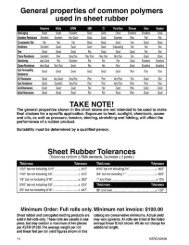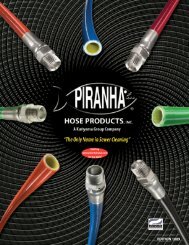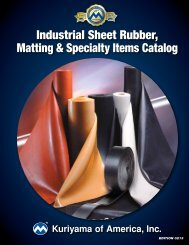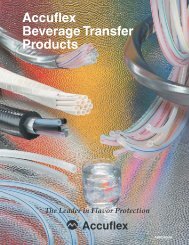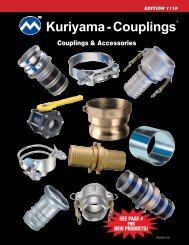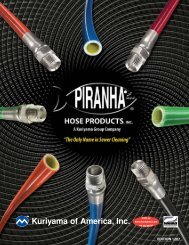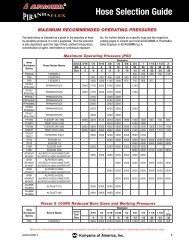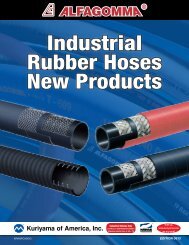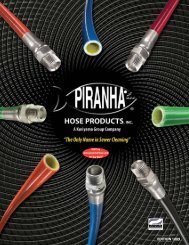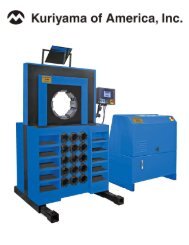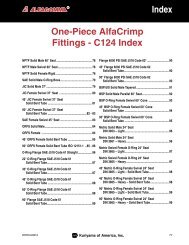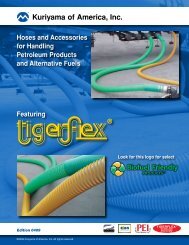Kuri-Tec tubing and hose - Kuriyama of America
Kuri-Tec tubing and hose - Kuriyama of America
Kuri-Tec tubing and hose - Kuriyama of America
Create successful ePaper yourself
Turn your PDF publications into a flip-book with our unique Google optimized e-Paper software.
®FITTING SUGGESTIONSFitting Suggestions for <strong>Kuri</strong> <strong>Tec</strong> ® Hose & TubingIt is extremely important that the fitting <strong>and</strong> <strong>hose</strong> or <strong>tubing</strong>be properly matched in size <strong>and</strong> type. The insert shouldalways be slightly larger than the <strong>tubing</strong> to create a slightexpansion <strong>of</strong> the tube <strong>and</strong> provide a good consistent seal.If a clamp or ferrule is used to compress the <strong>hose</strong>, cautionmust be used to prevent over-crimping the ferrule orover-tightening the clamp. More pressure does notnecessarily improve fitting retention.We do not recommend the use <strong>of</strong> reusable fittings unlessthe <strong>hose</strong> <strong>and</strong> fitting have been specifically designed tobe compatible <strong>and</strong> have been thoroughly tested incombination prior to use.Clamps over barbed fittingsdiameter for hydraulic fittings. For this reason, as ageneral rule we do not recommend the use <strong>of</strong> one-piececrimped hydraulic fittings with <strong>Kuri</strong> <strong>Tec</strong> <strong>hose</strong>s.Fig. 2AFig. 2BIn figures 2A <strong>and</strong> 2B above, two styles <strong>of</strong> crimping diehave been used successfully. The ferrules <strong>and</strong> fittings areproperly matched in length.Fig. 1AFig. 1CIn the illustrations above, the clamps are properlypositioned in Figure 1A <strong>and</strong> 1B, directly over the middlebarbs <strong>and</strong> behind the first barb. This is extremelyimportant in the case <strong>of</strong> single-barb fittings, as shown inFigure 1B, since the barb is generally much larger thanthe shank <strong>of</strong> the fitting. The compressed material cannotpass over the barb when under tension, thus securelyholding the fitting to the <strong>hose</strong>.In Figures 1C <strong>and</strong> 1D, the clamp has been improperlypositioned too close to the end <strong>of</strong> the fitting. In Figure1C, only the barb nearest the end <strong>of</strong> the fitting is effectivein maintaining fitting retention. The first two barbs serveno purpose whatsoever in providing fitting retention orleak resistance. In Fig. 1D, the situation is even worse,since the clamp can very easily cut the core tube over theenlarged barb, leading to leakage <strong>and</strong> subsequent coverblisters or bursts.When choosing multi-barb fittings for use with <strong>Kuri</strong> <strong>Tec</strong><strong>hose</strong>, as in Fig. 1A <strong>and</strong> 1C, it is important that the barbsnot be too deep. The core tubes in <strong>Kuri</strong> <strong>Tec</strong> <strong>hose</strong>s aregenerally somewhat harder than conventional rubbertubes <strong>and</strong> therefore the material cannot flow into the deepbarb, as it would with a s<strong>of</strong>t rubber compound.AcceptableFig. 1BFig. 1DUnacceptableFerrules crimped over barbed fittingsIn Fig. 2C, the ferrule is much shorter than the barbedinsert. Without the protection <strong>of</strong> the ferrule, repeatedharsh flexing <strong>of</strong> the <strong>hose</strong> at the fitting can damage thetube. In addition, the short ferrule does not take fulladvantage <strong>of</strong> the sealing or retention properties <strong>of</strong> thebarbed insert.In figure 2D, there are two potential problems: 1) Theexcessively-long ferrule can reduce the inside diameter<strong>of</strong> the <strong>hose</strong> just beyond the fitting; <strong>and</strong> 2) a single-barbfitting is not the ideal insert for a crimped ferrule. Because<strong>of</strong> the increased depth <strong>of</strong> the single barb, the tube can becut by the force <strong>of</strong> the crimping before sufficient compressionis exerted on the shank <strong>of</strong> the fitting.Compression FittingsCompression fittings depend solely on contact with theouter surface <strong>of</strong> the <strong>tubing</strong> to provide sealing <strong>and</strong> holdingpower. There is no seal on the inner surface <strong>of</strong> the <strong>tubing</strong>.With the exception <strong>of</strong> 220/221 Series LLDPE <strong>tubing</strong>, wedo not recommend the use <strong>of</strong> compression fittings with<strong>Kuri</strong> <strong>Tec</strong> <strong>hose</strong> <strong>and</strong> <strong>tubing</strong>. To work properly, the materialmust be hard <strong>and</strong> smooth <strong>and</strong> there must be no yarnreinforcement layer.Fitting suggestions for <strong>Kuri</strong> <strong>Tec</strong> ® spray <strong>hose</strong>sIn addition to the properly installed fittings shown in Fig.1A, 1B, 2A <strong>and</strong> 2B above, we also suggest the use <strong>of</strong> atwo-barb clamped fitting when high pressures are involved.When properly crimped, a metal ferrule over a multibarbedfitting can provide excellent fitting retention <strong>and</strong>leak resistance. However, excessive crimping pressurecan damage the core tube, leading to <strong>hose</strong> failure.ExtremePlease refercaretomustthealsobackbepagetakenfortothecontrollocationthe crimping<strong>of</strong> your nearest The warehouse double-barb for fitting, availability held in <strong>of</strong> place products/sizes by two properly shown.positioned clamps, provides excellent fitting retention <strong>and</strong>Because we continually examine ways to improve our products, we reserve the right to alter specifications OR DISCONTINUE PRODUCTS without prior notice.64 KKTCA0408Fig. 2CCompression SleeveFig. 2DPush-to-connect



